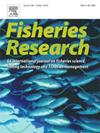标记布氏螺壳(腹足纲:蠓科)
IF 2.2
2区 农林科学
Q2 FISHERIES
引用次数: 0
摘要
标记生物矿物质是验证和监测钙化海洋生物生长的成熟技术。Bolinus brandaris是地中海和葡萄牙的一种具有商业价值的腹足动物,其生长和年龄不详,这阻碍了它的开发。本研究的主要目的是确定几种外壳标记技术的有效性:两种外部标记(塑料标签标签和指甲油),以及两种浓度(30和60 mg·L−1)和浸泡时间(3和6 小时)下的内部钙黄蛋白染色。454天后,死亡率仍然很低,外部标记保存完好。在这里测试的组合中,钙黄素在60 mg·L−1下处理3 小时产生最清晰的荧光和最佳的实验处理。这些发现支持将壳的外部和内部标记结合使用作为一种可靠的生长研究方法,以支持有科学依据的渔业管理决策。本文章由计算机程序翻译,如有差异,请以英文原文为准。
Marking Bolinus brandaris (Gastropoda: Muricidae) shells
Marking biominerals is a well-established technique for validating and monitoring the growth of calcified marine organisms. Bolinus brandaris, a commercially valuable gastropod in the Mediterranean and Portugal, has an unknown growth and age profile, which hinders its exploitation. The main objective of this study was to determine the effectiveness of several shell-marking techniques: two external marks (plastic label tags and nail polish), and internal calcein staining at two concentrations (30 and 60 mg·L−1) and immersion times (3 and 6 hours). After 454 days, mortality remained low, and external marks were well preserved. Of the combinations here tested, calcein treatment at 60 mg·L−1 for 3 hours yielded the clearest fluorescence and best experimental handling. These findings support the combined use of external and internal marking of shells as a reliable method for growth studies in support of science-backed fisheries management decisions.
求助全文
通过发布文献求助,成功后即可免费获取论文全文。
去求助
来源期刊

Fisheries Research
农林科学-渔业
CiteScore
4.50
自引率
16.70%
发文量
294
审稿时长
15 weeks
期刊介绍:
This journal provides an international forum for the publication of papers in the areas of fisheries science, fishing technology, fisheries management and relevant socio-economics. The scope covers fisheries in salt, brackish and freshwater systems, and all aspects of associated ecology, environmental aspects of fisheries, and economics. Both theoretical and practical papers are acceptable, including laboratory and field experimental studies relevant to fisheries. Papers on the conservation of exploitable living resources are welcome. Review and Viewpoint articles are also published. As the specified areas inevitably impinge on and interrelate with each other, the approach of the journal is multidisciplinary, and authors are encouraged to emphasise the relevance of their own work to that of other disciplines. The journal is intended for fisheries scientists, biological oceanographers, gear technologists, economists, managers, administrators, policy makers and legislators.
 求助内容:
求助内容: 应助结果提醒方式:
应助结果提醒方式:


